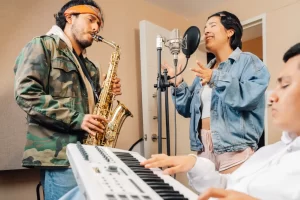A cappella, the art of vocal music without instrumental accompaniment, has woven a rich tapestry through music history. Rooted in religious chants and evolving through the barbershop quartets and doo-wop groups, a cappella has always been a testament to the pure power of the human voice. In recent years, this genre has witnessed a remarkable resurgence, capturing the hearts of audiences worldwide and showcasing the versatility and innovation inherent in vocal-only performances.
This article aims to delve into the vibrant world of a cappella music, tracing its evolution and examining its rising popularity in the modern music scene. A cappella is not just about harmonious vocals; it’s a genre that embodies creativity, collaboration, and a deep connection to the roots of musical expression. In our exploration, we will uncover how a cappella has moved from the sidelines to the spotlight, gaining mainstream attention through TV shows, movies, and social media platforms.
At its core, a cappella music is a celebration of the human voice in its purest form. It’s a genre that challenges artists to push the boundaries of vocal expression, creating a rich array of sounds and rhythms without any instrumental support. The resurgence of a cappella in contemporary times is not just a musical trend; it represents a shift towards authenticity and innovation in an industry often dominated by electronic effects and auto-tune. As we journey through the harmonious world of a cappella, we invite you to discover the magic of voices coming together, creating music that resonates with simplicity and power.
The Evolution of A Cappella Music
The evolution of a cappella music is a fascinating journey through history, showcasing the adaptability and enduring appeal of vocal-only performances. Originating from religious roots, a cappella was first heard in the solemn chants of medieval monasteries, where instruments were often deemed inappropriate for sacred settings. This tradition laid the groundwork for the genre, emphasizing the purity and emotive power of the human voice.
As time progressed, a cappella adapted to the changing musical landscapes. The Renaissance period saw a cappella flourish in the form of intricate vocal polyphony, where multiple voice parts interwove in a complex yet harmonious tapestry. This era’s compositions, often unaccompanied, highlighted the beauty and sophistication of vocal music.
The genre took a more casual and communal turn with the advent of barbershop quartets in the 19th century. These groups, characterized by their close, consonant four-part harmonies, brought a cappella into the realm of popular entertainment. The rise of doo-wop and jazz in the 20th century introduced new styles and rhythms to a cappella, further expanding its appeal and showcasing its versatility.
The digital era ushered in yet another transformation for a cappella music. With the advent of technology, artists began experimenting with innovative techniques like loop stations and vocal effects, pushing the boundaries of what could be achieved with the human voice alone. This period also witnessed the rise of virtual a cappella groups, where singers from different locations collaborate online, creating a global stage for this timeless art form.
Today, a cappella is not just a nod to the past but a vibrant and evolving genre that continues to challenge and inspire musicians. Its journey from the sacred halls of medieval churches to the viral videos of the internet era demonstrates the genre’s unique ability to adapt and thrive across different eras and cultures. A cappella music, in its essence, is a celebration of the human voice and its limitless potential to convey emotion and tell stories, unadorned by instruments yet rich in expression.
The Modern A Cappella Movement
The modern a cappella movement is a vibrant testament to the genre’s adaptability and enduring popularity. It has transcended its traditional roots to become a staple in contemporary music culture, fueled by a blend of innovation, technology, and a resurgence in community singing. This movement is characterized by a diverse array of groups, ranging from college ensembles to professional troupes, each bringing a unique flavor to the genre.
In recent years, college campuses have become hotbeds for a cappella, with numerous groups forming to showcase their vocal talents. These ensembles often become tight-knit communities, fostering not only musical skill but also camaraderie and teamwork. Their innovative arrangements and energetic performances have played a crucial role in popularizing a cappella among younger generations. Additionally, competitions like the International Championship of Collegiate A Cappella have gained prominence, providing a platform for these groups to display their prowess and creativity on a larger stage.
The influence of popular media has been instrumental in bringing a cappella to a broader audience. Television shows, movies, and online platforms have featured a cappella performances, sometimes as central themes, significantly boosting the genre’s visibility and appeal. The portrayal of a cappella in mainstream media has not only entertained but also inspired new waves of performers and enthusiasts.
Social media, too, has played a pivotal role in the modern a cappella movement. Platforms like YouTube have allowed groups and solo artists to share their work with a global audience, breaking geographical barriers and cultivating a widespread appreciation for vocal-only music. This digital exposure has led to the discovery of new talent and the viral spread of innovative a cappella performances, further solidifying the genre’s place in contemporary music culture. The modern a cappella movement, thus, represents a dynamic fusion of tradition and modernity, continuing to evolve and captivate audiences worldwide.
A Cappella as a Tool for Musical Education and Social Connection
A cappella music, beyond its entertainment value, serves as a powerful tool for musical education and fostering social connections. In educational settings, a cappella challenges students to develop a range of musical skills, from pitch accuracy and rhythm to harmony and dynamics. This form of vocal music, devoid of instrumental accompaniment, requires singers to develop a keen ear for tuning and blend, enhancing their overall musicality. It also encourages creativity and improvisation, as performers often arrange their own pieces, experimenting with different vocal techniques and styles.
The role of a cappella in music education extends to cultivating important life skills. Participating in a cappella groups teaches teamwork and collaboration, as each member’s voice plays a crucial role in the overall harmony. The process of rehearsing and performing together builds a sense of community and belonging among the members, fostering strong interpersonal bonds. For many students, a cappella becomes more than just a musical endeavor; it’s a platform for personal growth and forming lasting friendships.
Moreover, a cappella music has a unique way of creating social connections beyond educational contexts. Community a cappella groups bring together individuals from diverse backgrounds, united by their love for singing. These groups often become a space for cultural exchange and expression, where members share their musical heritage and experiences. For many, a cappella is a communal activity that offers a sense of belonging and an opportunity to connect with others.
A cappella serves as a bridge that connects individuals through the shared experience of music. Whether in schools or community centers, it promotes not just musical excellence but also social cohesion, making it an invaluable tool in both educational and social settings. As a cappella continues to grow in popularity, its role in nurturing musical talent and bringing people together becomes increasingly significant.
Innovations and Trends in A Cappella Music
The landscape of a cappella music is continually evolving, marked by exciting innovations and emerging trends that are reshaping the genre. One of the most significant developments in recent years is the incorporation of technology into a cappella performances. Artists are increasingly using loop stations and vocal effect processors to enhance their sound, creating rich, multi-layered compositions that challenge the traditional boundaries of a cappella. This fusion of human voice and technology has expanded the genre’s possibilities, allowing for more complex and varied soundscapes that were once unimaginable in vocal-only music.
Another trend in the a cappella world is the blending of genres, where groups are experimenting with a wide range of musical styles. From jazz and pop to classical and electronic, a cappella groups are diversifying their repertoires, attracting a broader audience. This genre-blending not only showcases the versatility of the human voice but also breathes new life into traditional a cappella, keeping it fresh and relevant.
Moreover, there’s a growing trend of original compositions in a cappella music. While covers of popular songs remain a staple, more groups and artists are writing their own music, giving a personal touch to their performances. These original pieces often reflect the unique identities and stories of the artists, adding depth and authenticity to their work.
In addition to these innovations, the a cappella scene is also seeing a rise in experimental sounds. Groups are pushing the envelope by exploring unconventional vocal techniques and arrangements, breaking away from the classic a cappella style. This experimental approach is not only a testament to the artists’ creativity but also a sign of the genre’s dynamic nature.
These innovations and trends underscore a cappella’s enduring appeal and its ability to adapt and thrive. As artists continue to explore new frontiers, a cappella music remains a vibrant and vital part of the musical landscape, constantly reinventing itself and captivating new audiences.
Challenges and Criticisms
The a cappella genre, while enjoying a resurgence in popularity, faces its share of challenges and criticisms. One significant challenge is balancing the essence of traditional a cappella with modern innovations. Purists argue that the increasing use of technology, such as loop stations and effects processors, detracts from the authentic a cappella experience, which relies solely on the human voice. This debate often centers around maintaining the genre’s integrity while embracing the opportunities that technological advancements offer.
Commercialization has also become a point of contention within the a cappella community. As the genre gains mainstream popularity, partly due to its portrayal in popular media and entertainment, there’s a concern that its artistic value might be compromised for mass appeal and profitability. This commercial aspect raises questions about the genre’s direction and the potential overshadowing of its artistic and communal roots.
Another criticism focuses on the intense nature of a cappella performances, particularly in competitive settings. The high demands placed on vocalists can sometimes lead to strain and health issues, highlighting the need for proper vocal training and care. Ensuring the health and well-being of performers is crucial, especially as a cappella continues to grow in both amateur and professional realms.
Furthermore, the genre faces the challenge of staying fresh and relevant in an ever-changing musical landscape. While innovation is key, there is the risk of alienating traditional audiences if the genre strays too far from its roots. Balancing innovation with tradition, commercial success with artistic integrity, and ensuring the health and sustainability of its performers are ongoing challenges that the a cappella community continues to navigate.
The Future of A Cappella Music
The future of a cappella music looks bright and diverse, as it continues to evolve and adapt in an ever-changing musical landscape. With technological advancements, we can anticipate further integration of innovative tools that enhance vocal performances, making them more dynamic and captivating. This fusion of technology and traditional vocal techniques will likely open up new avenues for creativity and expression within the genre. As a cappella artists continue to push the boundaries of what can be achieved with the human voice, we can expect to witness more complex and intricate compositions that challenge our perceptions of vocal music.
The rise of social media and digital platforms also promises a broader reach and greater accessibility for a cappella music. These platforms provide a global stage for artists, allowing them to connect with audiences worldwide and share their unique styles and sounds. The democratization of music production and distribution through these channels will likely lead to a more diverse array of voices and styles within the genre, enriching the a cappella scene with new influences and perspectives.
In addition, the educational aspect of a cappella music is poised to grow. More schools and community programs are likely to recognize its value in teaching musical skills, fostering creativity, and building social connections. This could lead to a greater emphasis on a cappella in music education, nurturing the next generation of vocal artists and enthusiasts.
However, maintaining the balance between innovation and tradition will remain a key challenge. As the genre evolves, it will be important to honor its roots while embracing new trends and technologies. The future of a cappella music will be shaped by how well it manages to stay true to its essence while continuing to innovate and captivate audiences worldwide.
To Sum It Up
To sum it up, a cappella music stands at a fascinating crossroads of tradition and innovation. Its journey from the sacred chants of old to the dynamic, technologically-enhanced performances of today illustrates the genre’s remarkable versatility and enduring appeal. As a cappella continues to evolve, it embraces new technologies and trends, widening its reach and resonating with a diverse, global audience. The future promises even more creativity and diversity, with advancements in technology and wider accessibility through digital platforms.
Yet, amidst this evolution, a cappella faces the challenge of balancing its rich heritage with the allure of modernization. The essence of a cappella – the raw, unadulterated human voice – remains its most compelling feature, and preserving this authenticity will be crucial. As the genre navigates the complexities of commercialization and innovation, its ability to maintain this balance will be key to its sustained relevance and growth.
Moreover, a cappella’s role in education and community building highlights its significance beyond entertainment. It’s not just a musical style but a tool for social connection, cultural expression, and personal development. As we look to the future, the continued nurturing of these aspects will ensure that a cappella music remains a vibrant and vital part of our cultural fabric.
A cappella music, with its unique blend of history, community, and innovation, is more than just a genre; it’s a testament to the power and versatility of the human voice. As it continues to adapt and thrive in the modern world, a cappella stands as a beacon of creativity and unity in an ever-evolving musical landscape.




